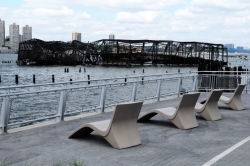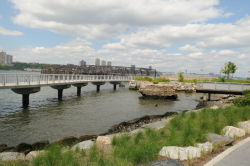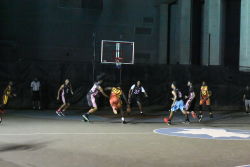Riverside Park South
Riverside Park South
What was here before?
Built on the former site of the New York Central Railroad’s 60th Street Yard, Riverside Park South was once the primary import, export, and classification area for Manhattan’s sole all-freight train line for over a century. At this yard, the New York Central Railroad operated bulk cargo piers and transfer bridges, including the extant 69th Street Transfer Bridge and gantry, which permitted fully laden freight cars to be rolled on and off barges on the Hudson River. The yard connected to Robert Moses’ West Side Improvement, including what is now the Empire Line under Riverside Park and the High Line as far south as Canal Street, and was often referred to as the “lifeline of New York” because the city depended on it for food and milk. The Central was preceded by the Hudson River Railroad, chartered in 1846, and merged with the New York Central Railroad in 1869 to form the New York Central and Hudson River Railroad.
The advent of new modes of transportation after World War II and the relocation of port activity to containerized facilities in New Jersey contributed to the decline of rail facilities in New York City. In 1968 the New York Central Railroad merged with the Pennsylvania Railroad; two years later, though, the new Penn Central Railroad declared bankruptcy, the largest in U.S. history at the time. In 1976, the 60th Street Yard, which received between 800 and 900 rail cars a day in its heyday, was abandoned.
Developers had long eyed the property. Edward Swayduck, then president of Local 1 of the Amalgamated Lithographers of America, envisioned “Litho City,” a “self-contained urban community” that never materialized. In 1985, Donald Trump bought the rights to the property and pursued plans for the large-scale projects “Lincoln West,” “Television City” (including the world’s tallest building), and “Trump City,” which never came to fruition. Opposition by community groups and elected officials, as well as economic conditions, prevented the construction of these projects.
How did this become a park?
In 1991, six non-profit civic groups—the Regional Plan Association, Municipal Art Society, Natural Resources Defense Council, Parks Council (now New Yorkers For Parks), Riverside Park Fund (now Riverside Park Conservancy), and Westpride, working with elected officials and city agencies—persuaded Trump and his majority partners to adopt an alternative plan known as Riverside South. It reduced the size of the development, proposed moving the elevated highway under a new Riverside Boulevard, and created a dramatic sweep of waterfront park. In 1992, the Riverside South plan was approved by the city, with a requirement for the developer to fund the creation of a park as well as its maintenance and programming in perpetuity. Nineteen buildings were eventually erected, and the parkland along the Hudson River waterfront deeded to the City of New York. Plans to relocate the elevated highway were put on hold in response to local elected officials’ hopes that Riverside South would not proceed with an elevated highway marring waterfront views. In 2005 the undeveloped area was sold to a succession of different developers.
The design of Riverside Park South by Thomas Balsley and Associates retains the industrial flavor of the 60th Street Yard and blends recreational space with thriving native ecosystems.
The National Historic Register 69th Street Transfer Bridge Landmark, an authentic locomotive stationed in the park, the abandoned pier piles still visible in the river, and the rusting floating bridge memorialize times and technologies past.
Riverside Park South hosts many programs, including outdoor arts, culture, and wellness events. The park is located along the NYC Water Trail and links sections of the Hudson River Greenway. It is also part of the Manhattan Waterfront Greenway, which enables exploration of much of Manhattan’s shoreline. Besides a wide array of amenities and charming spaces for both active and passive recreation, Riverside Park South offers visitors unparalleled views from Pier I.
Maintained by NYC Parks in collaboration with the Riverside Park Conservancy, Riverside Park South was constructed in five phases between 2001 and 2020 with a sixth and final phase scheduled for completion in 2023.
What is this park named for?
Riverside Park South sits just south of historic Riverside Park, named for its location on the eastern shore of the Hudson River.
Check out your park's Vital Signs
Clean & Safe
Green & Resilient
Empowered & Engaged Users
Share your feedback or learn more about how this park is part of a
Vital Park System











